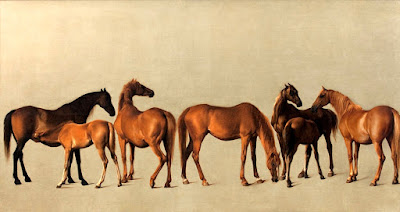 |
| Whistlejacket, 1762, George Stubbs. (National Gallery, London) |
“Why did George Stubbs not paint in a background in Whistlejacket?” is one of the most commonly-asked questions of art history. The short answer is, because he was such a good draftsman, he didn’t have to.
Stubbs himself related that he had placed the unfinished painting against a stable wall when Whistlejacket saw it. Thinking he was seeing another stallion rising to attack, the horse began “to stare and look wildly at the picture, endeavouring to get at it, to fight and kick it,” raising his handler off the ground. At that moment, Stubbs decided the painting was done.
That’s a great story, but it glosses over the fact that oil paintings are not usually developed as discrete subjects floating in empty space. The medium isn’t amenable to this kind of treatment. Oil paintings are generally developed as whole pieces, from the bottom layer up. Disregarding this requires the highest mastery of drawing, because there is no way to hide pentimentoon a plain background.
 |
|
Mares and Foals Without a Background, 1762, George Stubbs
|
Whistlejacket was one of several equine portraits Stubbs painted in 1762 during a stay at Wentworth Woodhouse in South Yorkshire. He was there on the invitation of Charles Watson Wentworth, Marquess of Rockingham. A leading grandee of the Whig party, Rockingham had been educated on the Continent. In short, he was a rarified British peer, separated from the rest of us by money, education and breeding. According to his wife, his primary interests were gambling and horses.
Stubbs painted at least three paintings without backgrounds while at Wentworth Woodhouse. Mares and Foals Without a Background and ‘Whistlejacket’ and Two Other Stallions with Simon Cobb, the Groom are both arranged carefully on long empty canvases. Whistlejacketcontinues that formality, rising in a classical dressage air. Since Whistlejacket himself was a notoriously temperamental racing stallion, the pose is almost certainly a fiction.
 |
|
Pangloss (“Rufus”), c. 1762, George Stubbs. (Indianapolis Museum of Art)
|
What strikes us as so modern about Stubbs’ horse silhouettes was probably a nod to classicism on his part, homage to the architectural friezes of Greece and Rome. This would have appealed to men of letters during the Age of Enlightenment. Stubbs went on to use the device in later animal and human portraits.
George Stubbs was born in Liverpool in 1724, the son of a currier. He worked with his father until the latter’s death in 1741, whereupon he was briefly apprenticed to a minor artist named Hamlet Winstanley. From then on, he was self-taught.
Stubbs was fascinated by anatomy, both equine and human. He spent six years studying anatomy at York County Hospital. Among his early works is a set of illustrations for a text on midwifery, from 1751.
 |
|
Plate from The Anatomy of the Horse, 1766, George Stubbs.
|
In 1756, Stubbs embarked on a quixotic quest for equal knowledge about horse anatomy. Hanging a series of horse carcasses from the rafters of a barn in the village of Horkstow, over the course of 18 months he flayed and sketched layer after layer of equine tissue.
Stubbs created a set of frontal, lateral, and posterior views that would become the basis of his book, The Anatomy of the Horse: including a particular description of the bones, cartilages, muscles, fascias, ligaments, nerves, arteries, veins, and glands. This treatise was hailed as a groundbreaking work of artistic and scientific merit and was the foundation of his future career.
Stubbs was curious about anatomy to the end. His last unfinished project, begun in 1795, was A comparative anatomical exposition of the structure of the human body with that of a tiger and a common fowl. It was unfinished at the time of Stubbs’ death at the age of 81.
